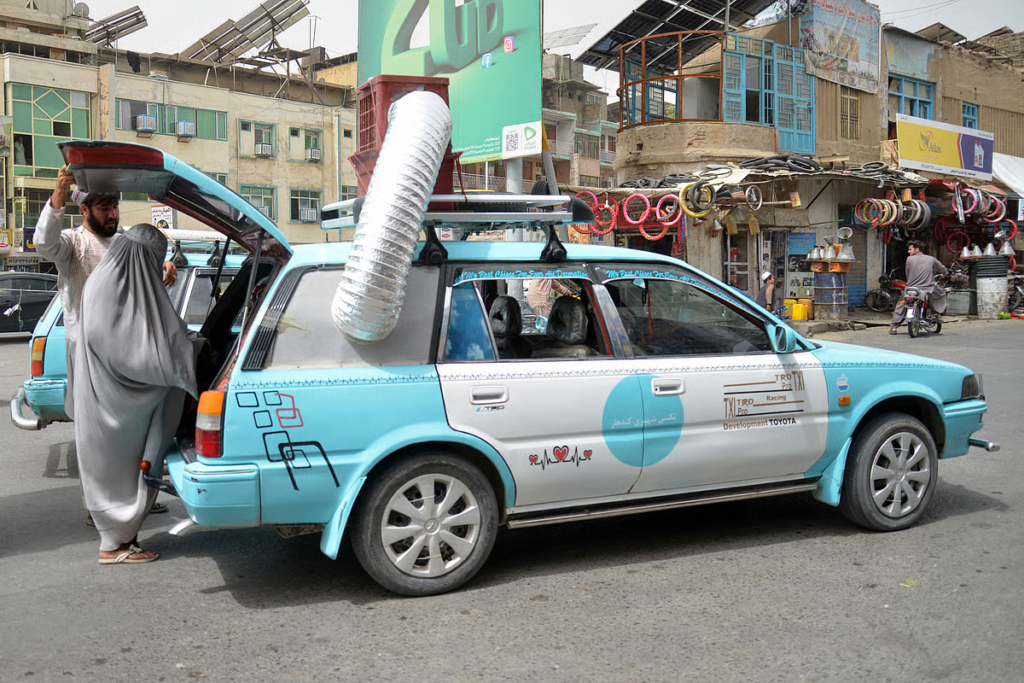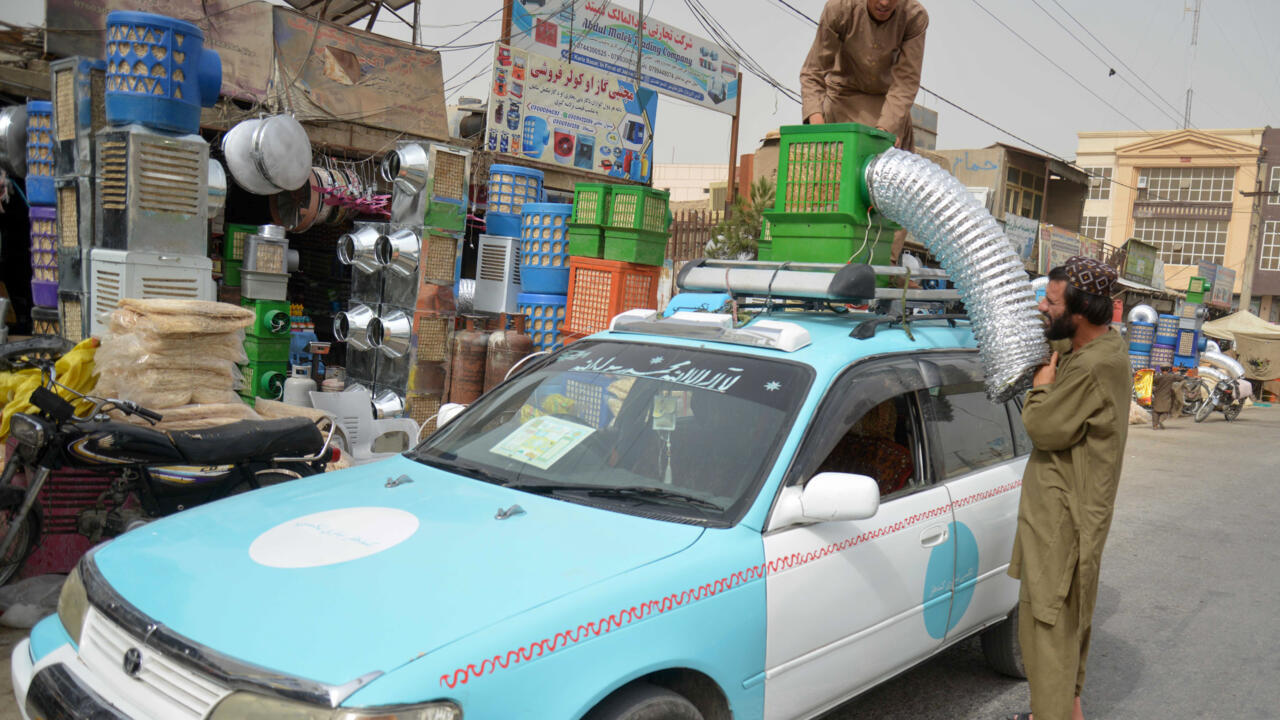Fatigued Afghan taxi drivers are now relying on creative and unusual methods to survive Kabul’s sweltering summer heat. With temperatures soaring above 40°C (104°F), lack of modern air conditioning systems in older vehicles is pushing drivers to explore cost-effective, innovative ways to cool themselves and their passengers.
As fuel prices increase and vehicle maintenance becomes more expensive, many Afghan taxi drivers are forced to work in extreme heat for up to 12 hours a day, often in outdated cars with no built-in AC systems. The struggle has led to a wave of low-cost, DIY cooling ideas that are spreading quickly across the city.
The Daily Heat Struggle Behind the Wheel
The capital city of Afghanistan, Kabul, sits at a high altitude but experiences intense heat during summer. Most taxis operating in the city are over 15 years old. These cars rarely have working air conditioning systems. Drivers spend long hours stuck in traffic with hot engine air blowing directly into the cabin.
“I feel like I’m sitting in an oven all day,” says Abdul Wali, a 39-year-old taxi driver from western Kabul. “I can’t afford to repair the AC, and even if I could, using it all day burns too much fuel.”
These fatigued Afghan taxi drivers have begun using several unusual yet surprisingly effective methods to battle the heat while staying on the road.

Innovative and Cheap AC Hacks Gain Popularity
In a city with low average monthly incomes, expensive fixes are out of reach. As a result, drivers have developed their own “cooling hacks,” using materials easily available in local markets.
1. Ice-Filled Containers as Mini Coolers
Some drivers place small ice-filled containers or plastic bottles under the dashboard or next to the gear. The melting ice creates a cooling effect inside the car, especially when paired with battery-operated mini fans that circulate the cooler air.
Wali explains, “It only costs me 30 afghanis for ice every morning. It doesn’t last the whole day, but it makes the heat bearable for at least three to four hours.”
2. Wet Towels on Dashboard and Seats
A surprisingly effective method includes laying wet cloths or towels over the seats or dashboard. The evaporation of water helps lower the car’s interior temperature. This traditional trick, passed down for generations, uses the basic science of evaporation for cooling.
“I’ve used this method since my father drove a taxi,” says 50-year-old Zahir Khan. “It’s simple, cheap, and works better than many machines.”
3. Portable USB Fans Powered by Solar Panels
A more modern approach is gaining popularity among younger drivers. Small solar panels placed on the car’s roof charge USB fans placed on the dashboard or seat backs. These fans help circulate air, especially when windows are slightly opened for ventilation.
Some even connect the fans to small water mist sprayers to replicate a mist AC system.
“It’s not perfect, but it gives passengers some comfort,” says 26-year-old driver Hamidullah, who spent about 1,200 afghanis (around $15) to set up his system.
Fuel Prices Make AC Usage Impossible
One of the biggest reasons behind this growing trend is the sharp rise in fuel prices in Afghanistan. Many drivers say they cannot afford the extra fuel consumption that comes with running a vehicle’s AC.
“We already struggle to earn enough to feed our families,” says Zahir. “Running the AC for even one hour can burn 10 to 15% more fuel.”
Given the difficult economic conditions, many drivers say they are forced to either work in the heat or stop driving altogether. The fatigued Afghan taxi drivers often face headaches, dizziness, and extreme fatigue by the end of a working day.

Health Risks on the Rise
Experts warn that long-term exposure to high temperatures inside vehicles can lead to serious health issues. Drivers are at risk of dehydration, heatstroke, and fatigue, which can also increase the chance of traffic accidents.
Dr. Ramin, a general physician in Kabul, notes, “Taxi drivers working 10 to 12 hours in high heat without proper ventilation are damaging their bodies. Many report frequent headaches and high blood pressure.”
He urges local authorities and public health departments to raise awareness and provide low-cost cooling solutions to this vulnerable group.
Passenger Comfort Still a Priority
Despite their struggles, most drivers try to maintain comfort for their passengers. Some offer chilled bottled water for free. Others allow passengers to control small fans or even open roof vents if available.
Driver Hamidullah says, “If a passenger feels uncomfortable, they may avoid taxis next time. We try our best to make the ride pleasant, even in this heat.”
Government and NGO Support Still Missing
There is little to no government assistance or NGO support for helping taxi drivers deal with climate-related challenges. Many drivers hope that either local officials or transport unions will introduce schemes to help modernize old vehicles or offer subsidies for installing proper cooling systems.
Without help, the drivers believe they will continue to suffer in silence. “We are the lifeline of the city,” says Wali. “But no one listens to our pain.”
Future of Driving in Kabul
As Kabul continues to grow, traffic congestion and extreme weather are expected to worsen. Without affordable and Eco-friendly transport solutions, fatigued Afghan taxi drivers may begin to leave the profession, pushing up ride costs and reducing transport availability for ordinary citizens.
Until then, these creative hacks will continue to spread among drivers as survival tools in a hot and tiring profession.
Do follow Gulf Magazine on Instagram
Also Read – Fun for All Ages Dubai Waterparks Offer Best Family Day



